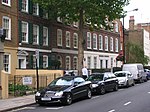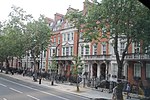Lower Belgrave Street
BelgraviaStreets in the City of Westminster

Lower Belgrave Street is a street in London's Belgravia district. It runs north-west to south-east and begins as a continuation of Upper Belgrave Street where it meets Eaton Square. It crosses one through-street, Ebury Street, and ends in a t-junction facing Victoria station's west front at Buckingham Palace Road. Among the notable buildings are a mid-19th-century (initial category, Grade II-listed) Plumbers Arms at no 14. Another is a small primary school.
Excerpt from the Wikipedia article Lower Belgrave Street (License: CC BY-SA 3.0, Authors, Images).Lower Belgrave Street
Lower Belgrave Street, London Belgravia
Geographical coordinates (GPS) Address Nearby Places Show on map
Geographical coordinates (GPS)
| Latitude | Longitude |
|---|---|
| N 51.496616666667 ° | E -0.148025 ° |
Address
Knight Frank
Lower Belgrave Street 47
SW1W 0LN London, Belgravia
England, United Kingdom
Open on Google Maps










